By Jeffrey A. Rendall, Photos by Jeffrey A. Rendall
WILLIAMSBURG, VA – Pete Dye’s a candid man. When I asked why he went in and renovated Kingsmill Resort’s River Course (starting) in May of 2004, he replied: “Because Anheuser-Busch (Kingsmill’s owner) had screwed it up for the last twenty years. How’s that for an answer?”
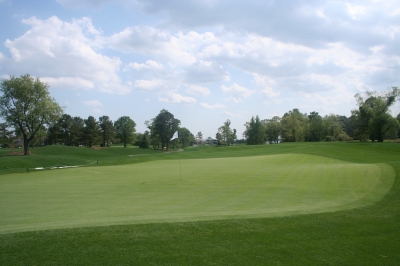 |
| The River Course's 1st hole is a gentle ease-in to a challenging golf course. At 369 yards and forever wide, you'll probably start the day out with a smile. |
Dye did say it with a chuckle, but he also reiterated that the course’s recent reformation didn’t come about by accident. He said that golf courses change so much over the run of a couple decades that they usually need to be re-worked, and that even a distinguished layout like the River Course was not immune to the inevitable deteriorations caused by time, weather… and some well intentioned, but not-so-wise alterations to the original.
The pre-renovation consensus was the River Course’s greens needed the most work. Dye explained that when he originally designed the course back in the early seventies, he still put a lot of slope into his putting surfaces: “When I first started building golf courses, I went out and looked at all the old Seth Raynor and Donald Ross greens that hadn’t been changed much up to those days. The slopes they had in those greens – in a ten foot period, they would drop a foot.”
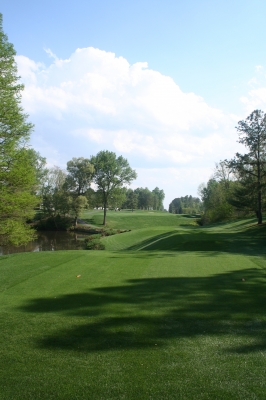 |
| The tee shot of the par five 15th hole looks daunting, but there's a huge amount of room to land the ball out there. To have a good angle for your second shot, you will need to keep the ball to the right side of the fairway. |
Dye continues, “Today, if you did something like that, you can’t mow it, because the ball will just run right off it. So when I built Kingsmill, I was still on that ‘kick,’ letting the ball drop a foot in every ten feet. The speeds weren’t so ridiculous back then, and you could get away with bigger slopes in the greens.”
The River Course opened for play in 1975, and Dye points out that speeds at that time were about eight on the Stimpmeter. Now, you rarely see green speeds – at least on upscale courses like the River Course – of less than ten. And sometimes you’re getting eleven or twelve. Today, just tap the ball and it goes the same distance with less slope than the old days.
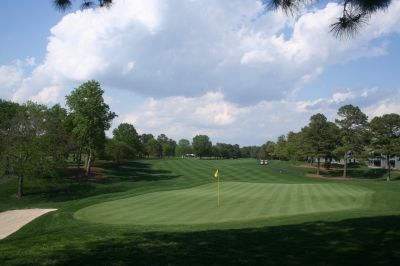 |
| Looking back from the green of the 467-yard, par four 9th hole -- definitely one of the most difficult on the course. |
“This time (2004), we rolled the greens and slowed ‘em down to five or six or seven inches of drop in every ten feet,” Dye explained. “Then, where the pins used to be, they’d roll off at about three inches in every ten feet. So, we slowed the pin areas down to an inch or inch and a half. It was all modified for what’s going on today.”
“I hate fast greens, and I’ve always been against the way they’re being cut today. But I don’t run the world, and you just have to make the best of what people are doing now,” Dye said.
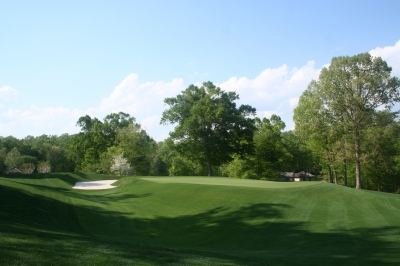 |
| There's all the room in the world to leave it short on the par four 12th hole, but that'll leave a challenging up-and-down ahead of you. And if you're long, you're in trouble. |
Don’t forget your ruler the next time you go to a Dye golf course – at least one of the newer ones, or one that’s been renovated. Dye’s always been on the cutting edge of golf design, and he’s certainly up there in golf logistics as well. He’s known for a lot of original, if ‘quirky’ elements around the greens. Playing one of his courses is never boring -- but they’re always fair, to his credit.
Dye isn’t the only one who thinks the River Course is ‘new and improved’ over the previous version. Chris Hartig, Head Golf Professional at the River Course, says what Dye did only made a great course better, by making it much more playable for average players.
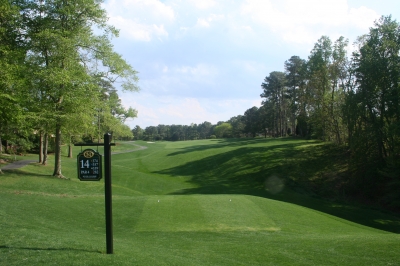 |
| There are lots of postcard quality views at Kingsmill. Here's the view from the tee of the par four 14th hole. |
“We made the changes to accommodate a wider variety of golfers,” Hartig said. “Prior to the renovation, almost all of the River Course’s greens were elevated and required a forced carry to get your ball on the green. Now, many of the holes have changed so that one portion of the green is accessible without a forced carry – which gives higher-handicapped players a better option when playing the hole.”
It may be easier for some duffers to get to the greens, but have no fear, the River Course still has plenty-sharp fangs waiting for the scoring shots.
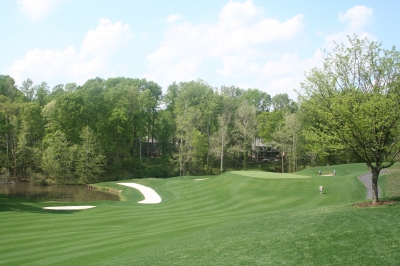 |
| The par five 3rd hole is another that was 'fixed' by Dye in 2004 -- graded out for a much gentler slope to land the ball on. |
Again, Hartig explains: “While there are now run-up options to get to the greens, they only cover a portion of the surface. To get it close for easy pars or birdie opportunities, many hole locations require distance-controlled shots to carry bunkers or elevated greens that will challenge low handicap and scratch golfers. So it’s still difficult to make birdies and pars on many holes for the scratch golfer, but the average golfer who plays a smart game has better chance of turning double bogeys into bogeys or pars.”
The River Course remains quite a test for the best players, as was demonstrated by the two Michelob Ultra Opens that were played there since its remake. Karrie Webb may have won with a total of fourteen-under-par in the 2006 version, but the River Course’s tricky challenges forced Annika Sorenstam to miss the cut for the first time since 1994 in a non-major championship.
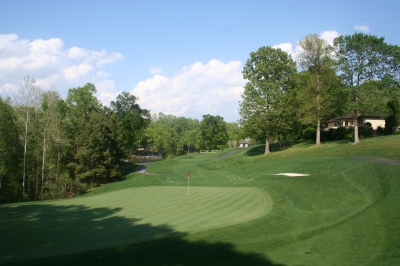 |
| Here, the par three 13th hole. The pin in this photo is close to the one where Natalie Gulbis made a hole-in-one during the 2006 Michelob Ultra Championship. |
For their part, the players had nothing but praise for the changes and conditions they found. Karrie Webb, after her Saturday round, wished she could play everyday on a course that was in such great shape. And a big reason why the greens are so perfect was the switch to A-4 bentgrass, which is more suited to the local climate and allows for a smoother, faster putting surface.
In addition to redoing the greens, the River’s tee boxes were expanded, fairways reshaped, and every bunker on the course was rebuilt. Dye said it was a complete renovation, and he’s very proud of the work that was done… especially to the par four eighth hole.
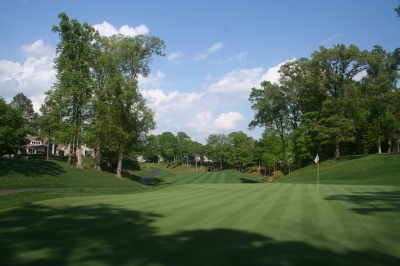 |
| Pete Dye said the 8th hole was a terrible golf hole prior to the renovation. It's always been pretty, now it's fair, too. |
“A lot of people used to say the eighth hole was a tough golf hole. It wasn’t tough, it was just terrible,” Dye said, in his usual hold-nothing-back style. “Somewhere along the line, the eighth was moved from its original routing, and the new location had a horribly sloped landing area, so we went in there and graded the landing area, made it much bigger and wider. Then we graded out and around the green so it’s much more playable.”
Dye said similar treatments were done on several other holes, such as the landing areas on the par five third and seventh holes, as well as the par four fourth hole. Additional work (on the entire course) included moving the cart paths so they wouldn’t come into play, and also installing a completely new drainage and irrigation system to improve the already excellent playing surfaces.
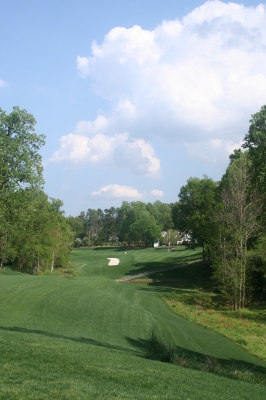 |
| A vertical view from the 4th tee -- makes it seem narrower than it is, but you'll still need to hit it pretty straight here. |
The River Course has always been reasonably forgiving off the tee (with a few tight holes), so the fairway grading work only made it more generous in that respect. Hartig stressed that the layout’s strongest suit continues to be its emphasis on accurate iron play – and at ‘only’ 6831 yards from the back tees, the course needs some more difficult short-game challenges to keep it current with the latest equipment technology.
That being said – it’s now probably too short for a PGA Tour event, which it held for over twenty years, prior to the arrival of the LPGA in 2003. But it’s just perfect for the ladies, who don’t need to play it at its maximum yardage total.
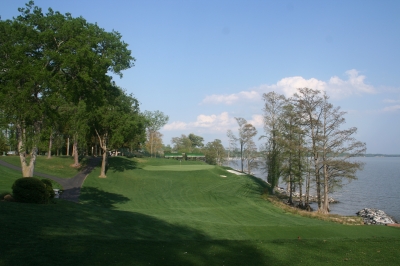 |
| The par three 17th hole gets a lot of TV coverage. The river doesn't come into play for the pros, but I still bet there are a lot of golf balls down that hill. |
A good example of the difference between the two tours is how they approach the par four sixteenth hole, which played at just over 400 yards in the Michelob Ultra Open. It’s usually ‘lengthened’ by a stiff breeze off the James River, and the women were hitting mid-irons or even utility woods into the green – whereas the men would be using short-irons and wedges into the same hole.
After witnessing the action at the LPGA event, it was interesting to see Hartig’s words in ‘action,’ as the professionals needed to land the ball on certain parts of the greens and count on the slopes to bring the ball towards the hole. There’s not a lot of ‘luck’ involved in shooting a low score – you’ve got to be able to work the ball and hit to spots, and let Pete Dye’s design do the rest.
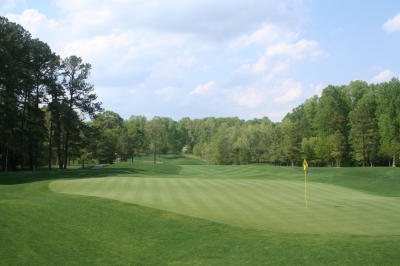 |
| Any way you slice it, the short par four 6th hole (369 yards) is one of the easier links on the River Course. Take advantage of it. |
Karrie Webb played it the best in 2006. She was in a zone.
And while you’ll obviously come to Kingsmill to golf, it’s hard not to notice the historical significance of the property when you’re there – and the resort makes no attempts to hide it, with several interpretive signs and even a few cannons to accent the landscape. The history is perhaps most noticeable on the Plantation Course, but we saw several patrons at the ‘Ultra’ reading the signs as well.
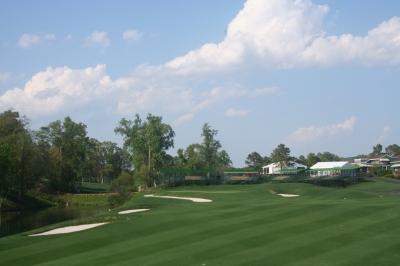 |
| Here's the approach shot view from the par four 18th hole. Dye shifted the green much farther to the left, which even brings Moody's Pond into play now. |
The par three seventeenth hole features Burwell’s Landing, which became a major port of entry for Williamsburg during the eighteenth century, and played a significant part in the American Revolution. The landing’s water pilings are still visible from the hole, as are earthworks that were constructed during the Revolution and later rebuilt by the Confederate forces during the Civil War.
Back to the present -- one thing that needed no renovation was Kingsmill’s commitment to service. Hartig explains what he wants people to take away from a visit to Kingsmill – be it the professionals, or resort visitors: “We want to exceed golfers’ expectations, from course conditions to unparalleled service. We hope that guests who play the River Course go home and talk about not only playing the same course that Tour professionals play, but also enjoy every minute of it when they’re here.”
“Many average golfers leave courses that host Tour events feeling beat up, like they never had a chance to play well. We hope all our guests will recognize that although the River Course is very challenging to the best of players, it’s also very fair and reasonable for the average golfer. In my opinion, that’s the true measure of a well designed golf course,” Hartig concluded.
The River Course was fun and entertaining prior to Mr. Dye’s recent work, but there’s little doubt it’s a better course today because of the changes. Before, you could hit good tee shots (on some of the quirky fairways) that would end up in bad spots, and with the new greens, it’s easier to plot your way of approach – and once you’re there, it’s much more fair with the slopes and the flat-stick.
In the end, Dye was right. It’s always good to go back and ‘fix’ what time has undone… or was ‘screwed up’ in one way or another.
Details:
The River Course at Kingsmill Resort
Telephone: (757) 253-3906
Website: http://www.kingsmill.com/
Head Golf Professional: Chris Hartig
Course Designer: Pete Dye
Tees/Yardage/Slope/Rating:
Gold 6831 139/74.7
Blue 6326 138/71.0
White 5640 132/67.9
Red 4814 124/69.2
Rates:
In Season rate is $175; $125 after 2 p.m.
| Related Links | Comments on this article? | |
|
Maryland National Golf Club Hollow Creek Golf Club Rocky Gap Resort PB Dye Golf Club in Ijamsville Whiskey Creek Golf Club |
E-mail Jeff Rendall, Editor: jrendall@golftheunitedstates.com |











